
Edward Wells, A New Map of the Most Considerable Plantations of the English in America, Oxford, England, 1700–1730. Engraving with watercolor on paper. 13 11/16" x 18 5/8". (Courtesy, Historic Deerfield, Inc., Albert and June Lauzon Collection, gift of Mrs. June Lauzon.)
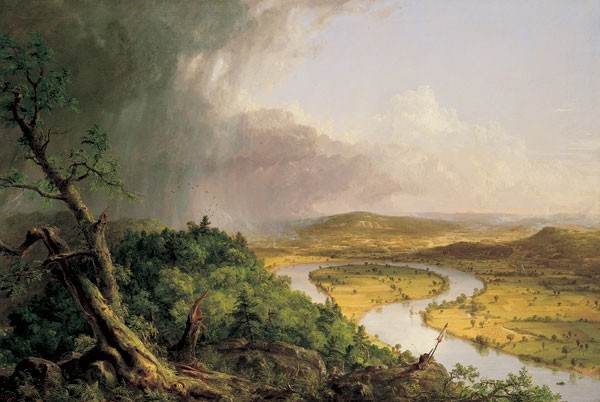
Thomas Cole, The Oxbow, 1836. Oil on canvas. 51 1/2" x 76". (Courtesy, Metropolitan Museum of Art, gift of Mrs. Russell Sage, 1908.)
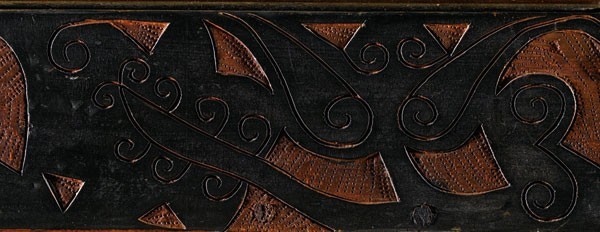
Detail of the tulip-and-leaf decoration on the chest illustrated in fig. 5. (Photo, Gavin Ashworth.)
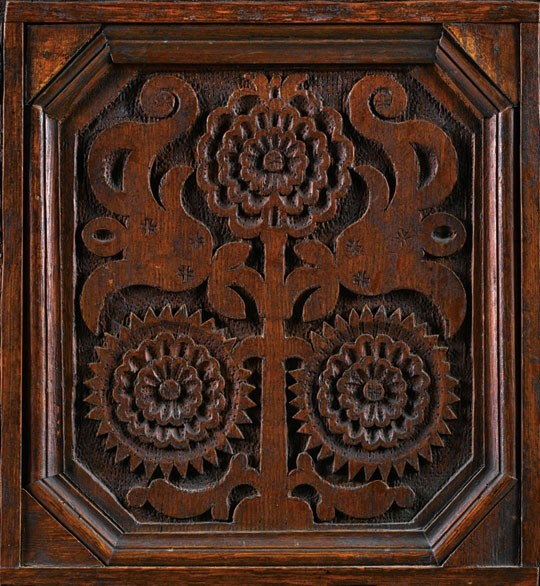
Detail of the carved center panel of the chest illustrated in fig. 63. (Photo, Gavin Ashworth.)

Chest, Hatfield or Hadley, Massachusetts, 1715–1720. Soft maple, chestnut, and oak with white pine. H. 44 3/4", W. 45 5/8", D. 19 7/8". (Courtesy, Historic Deerfield, Inc., gift of Dr. Ogden B. Carter Jr.; photo, Gavin Ashworth.) The paint is not original.
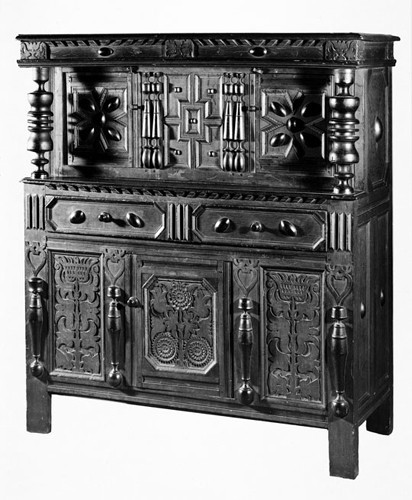
Cupboard, Hartford County, Connecticut, ca. 1680. Red oak, white oak, white pine, cedar, poplar, and maple. H. 56", W. 49 1/4", D. 20 5/16". (Courtesy, Yale University Art Gallery, gift of Charles Wyllys Betts.)
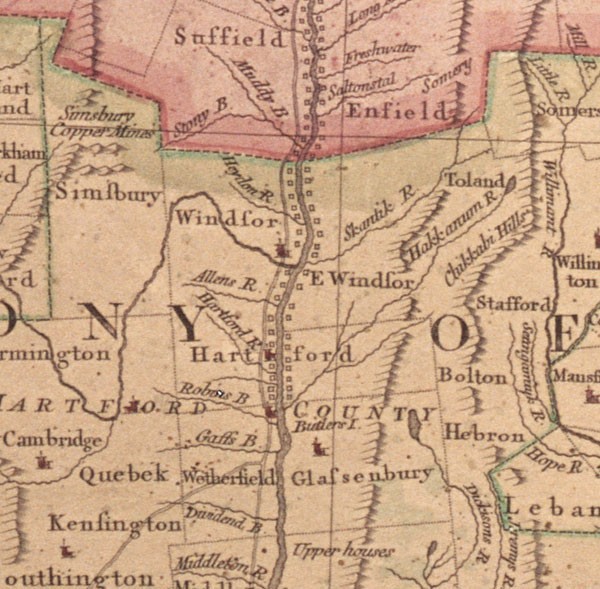
Detail of Tobias Conrad Letter, A Map of the Most Inhabited Part of New England, Augsburg, Germany, 1776. Engraving with watercolor wash on paper. 39 1/2" x 42". (Courtesy, Historic Deerfield, Inc.) This map was based on another map drawn by Braddock Mead (alias John Green) and published by Thomas Jefferys, London, 1755.

Detail of the map illustrated in fig. 1.

Embroidery patterns illustrated in Giovanni Andre Valvassore’s Esemplario di lavrio (Venice, 1552) and Giovanni Ostaus’s Vera perfettiono del desegno (Venice, 1557). (Private collection; photo, Gavin Ashworth.)

Elizabeth White, sampler, Hatfield, Massachusetts, before 1688. Wool on linen. 13 3/4" x 6 3/4". (Courtesy, Historic Deerfield, Inc.)

Chest attributed to Thomas Barber Sr., Windsor, Connecticut, 1640–1662. Oak with yellow pine and oak. H. 23 3/4", W. 54", D. 23 1/4". (Courtesy, Pocumtuck Valley Memorial Association, gift of Mrs. Catherine W. Hoyt; photo, Gavin Ashworth.) The stiles have been shortened and the lid and till are missing.
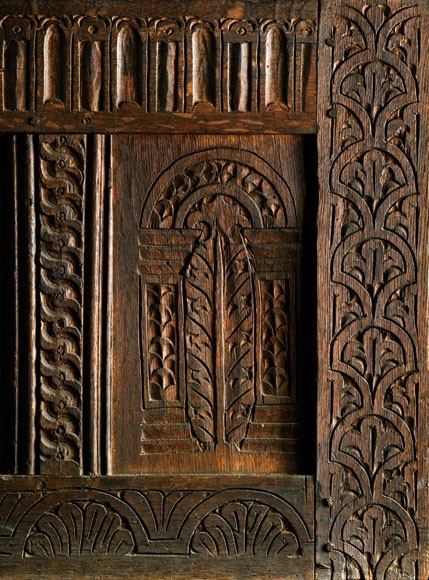
Detail of the carving on the façade of the chest illustrated in fig. 11. (Photo, Gavin Ashworth.)
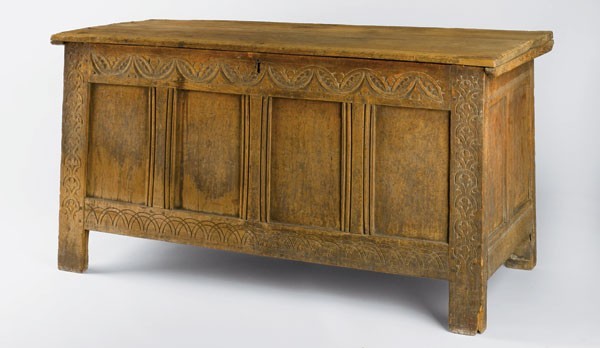
Chest attributed to Thomas Barber Jr., Windsor or Simsbury, Connecticut, ca. 1662. Oak with yellow pine and oak. H. 28 5/8", W. 55 1/2", D. 24 1/4". (Courtesy, Connecticut Historical Society; photo, Gavin Ashworth.)

Detail showing a spline used to join the lid boards of the chest illustrated in fig. 13. (Photo, Gavin Ashworth.)
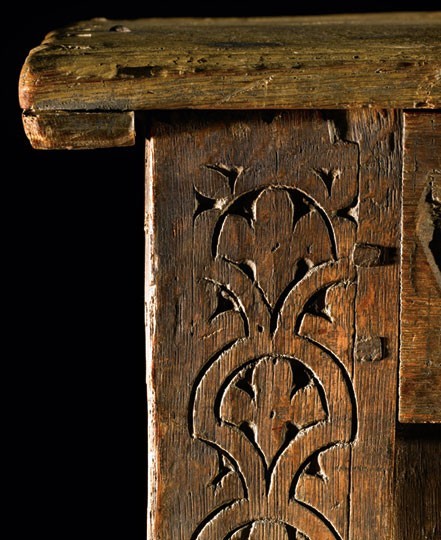
Detail of the carving on the left stile of the chest illustrated in fig. 13, showing the tessellated trefoil found in the same locations on all examples attributed to the Barber shop. (Photo, Gavin Ashworth.)
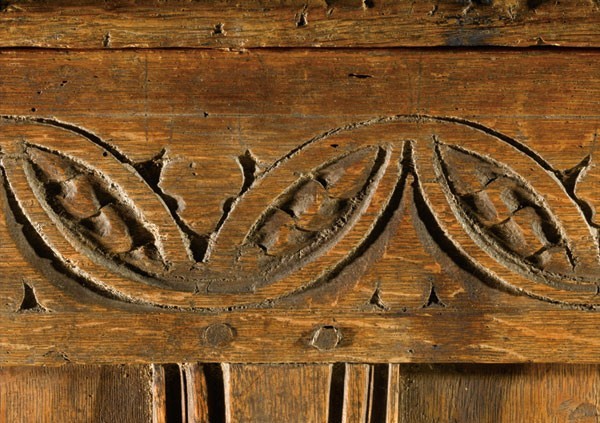
Detail showing the carving on the upper rail and molding on the muntins and lid of the chest illustrated in fig. 13. (Photo, Gavin Ashworth.)

Box attributed to Thomas Barber Sr., Windsor, Connecticut, before 1663. Oak. H. 4 3/8", W. 8 5/8", D. 5 1/4". (Private collection; photo, Gavin Ashworth.) The lock is missing.

Detail showing the waxed linen lining on the bottom board of the box illustrated in fig. 18. (Photo, Gavin Ashworth.)
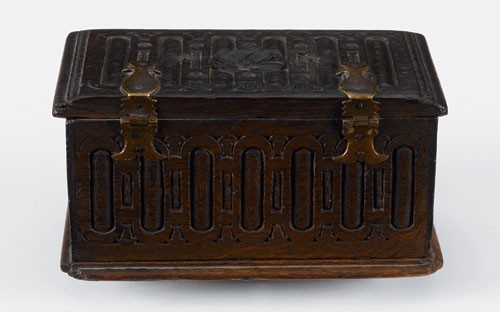
Back of the box illustrated in fig. 18. (Photo, Gavin Ashworth).
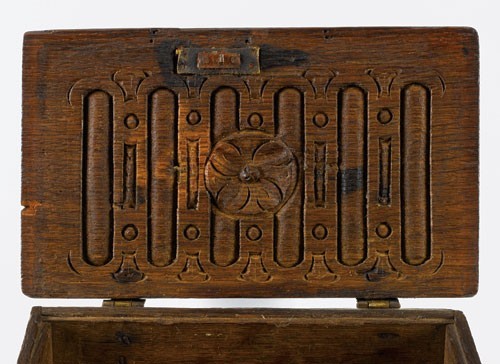
Detail showing the carving on the inner surface of the lid of the box illustrated in fig. 18. (Photo, Gavin Ashworth.)

Box attributed to Thomas Barber Sr., Windsor, Connecticut, before 1663. Woods and dimensions not recorded. (Wallace Nutting, Furniture Treasury, 2 vols. [Framingham, Mass.: Old America Co., 1928], 1: fig. 163.)
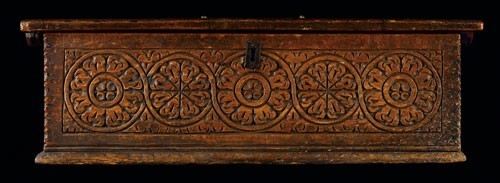
Box attributed to William Buell, Windsor, Connecticut, 1640–1681. Oak with pine. H. 8 1/2", W. 27", D. 18". (Courtesy, Oneida Historical Society, Utica, NY.)
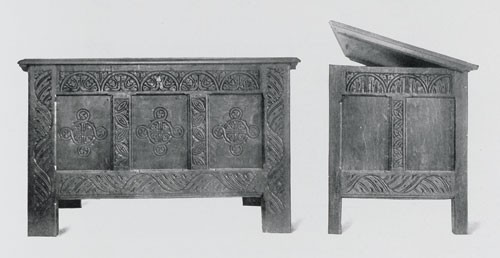
Chest, Windsor or Killingworth, Connecticut, ca. 1660. Woods and dimensions not recorded. (Luke Vincent Lockwood, Colonial Furniture in America, 2 vols. [New York: Castle Books, 1921], 1: 27, fig. 11.)

Box, Windsor or Killingworth, Connecticut, ca. 1660. Woods and dimensions not recorded. (Wallace Nutting, Furniture Treasury, 2 vols. [Framingham, Mass.: Old America Co., 1928], 1: fig. 158.)
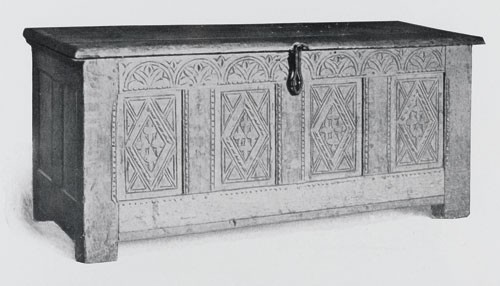
Chest, Windsor, Connecticut, before 1662. Woods and dimensions not recorded. (Luke Vincent Lockwood, Colonial Furniture in America, 2 vols. [New York: Castle Books, 1921], 1: 27, fig. 10.)
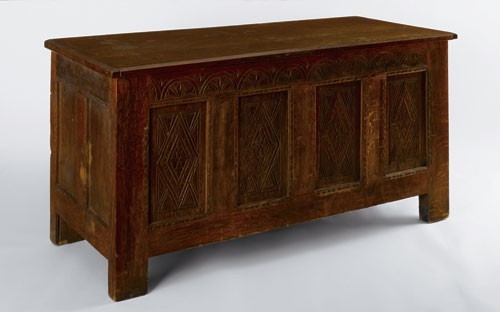
Chest, Windsor, Connecticut, ca. 1660. Oak. H. 24 1/2", W. 48 1/4", D. 19 3/4". (Private collection; photo, Gavin Ashworth.) The lid and floor boards are replacements.
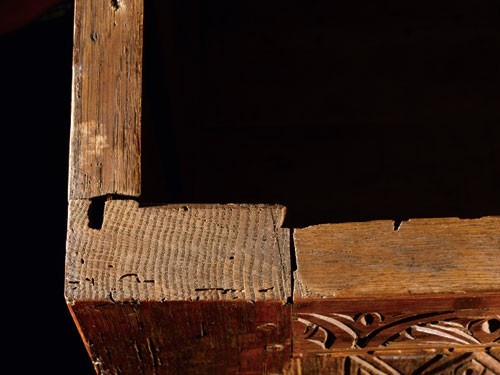
Detail showing the cross section of the left front stile of the chest illustrated in fig. 28. (Private collection; photo, Gavin Ashworth.)

Great chair, Windsor, Connecticut, ca. 1660. Oak. H. 47 1/2", W. 23 5/8", D. 17 3/4". (Courtesy, Museum of Fine Arts, Boston, gift of Aimee and Rosamond Lamb.) The feet, stretchers, and seat are replacements, and the paint is modern.
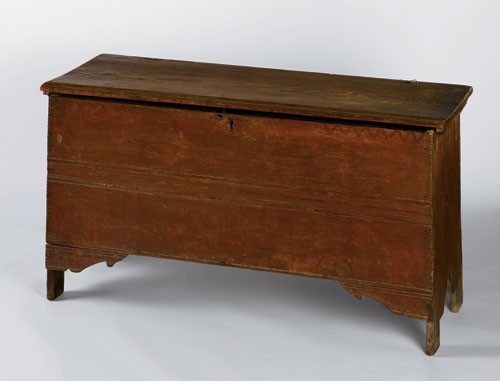
Chest attributed to John Rockwell III, Windsor, Connecticut, ca. 1700. Yellow pine and oak with yellow pine. H. 27", W. 49", D. 18". (Courtesy, Historic Deerfield, Inc., gift of Thomas C. Frary in memory of Margery Collins Frary.)
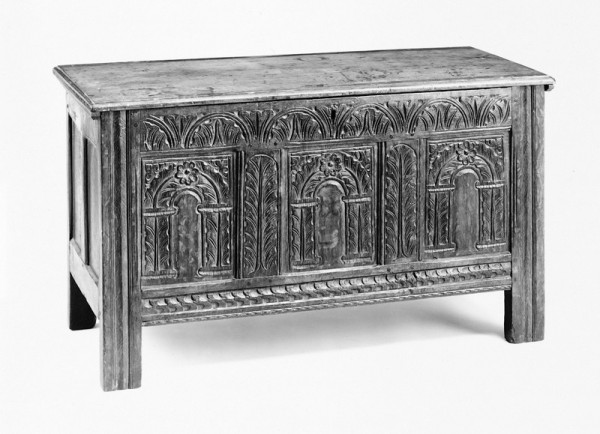
Chest attributed to John Rockwell I or John Rockwell II, Windsor, Connecticut, ca. 1660. Oak. H. 27", W. 48", D. 19 3/4". (Courtesy, Yale University Art Gallery, Mabel Brady Garvan Collection.) The white pine lid is a replacement.

Chest attributed to John Rockwell I or John Rockwell II, Windsor, Connecticut, ca. 1660. Oak. H. 26 1/4", W. 48 1/2", D. 20 1/2". (Private collection; photo, Gavin Ashworth.) The lid is a replacement.
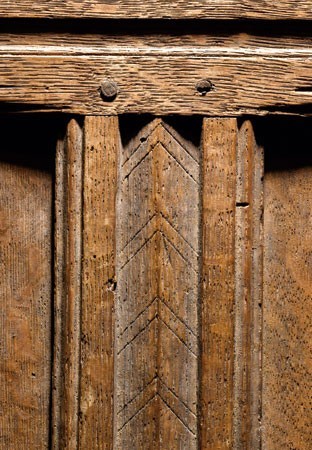
Detail of the chest illustrated in fig. 35, showing the angled convex molding and incised chevrons on the muntins of the façade.
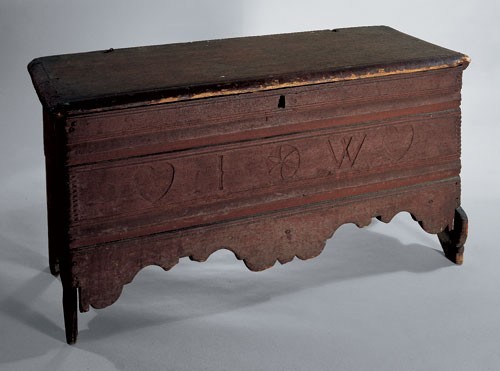
Chest, probably Hartford County, Connecticut, ca. 1720. Tulip poplar. H. 23", W. 46", D. 17 1/2". (Private collection; photo, Nathan Liverant & Son Antiques, Inc.)

Box attributed to John Moore I, Windsor, Connecticut, ca. 1670. Oak with yellow pine. H. 8 1/2", W. 29", D. 15 1/2". (Courtesy, Metropolitan Museum of Art, gift of Mrs. Russell Sage.)

Detail showing the notch cut in the upper inside face of the back board of the box illustrated in fig. 38.
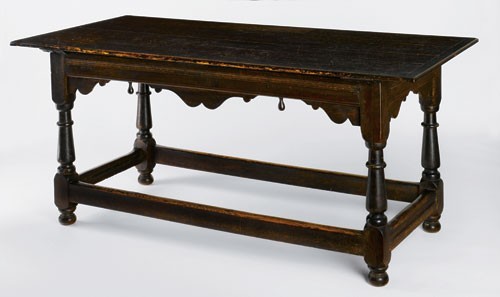
Table attributed to John Moore II or John Moore III, Windsor, Connecticut, ca. 1680. Oak. H. 31", W. 70", D. 32 3/4". (Courtesy, Connecticut Historical Society, gift of Harold G. Holcombe; photo, Gavin Ashworth.) The top, pendants, and most of the brackets are replacements.
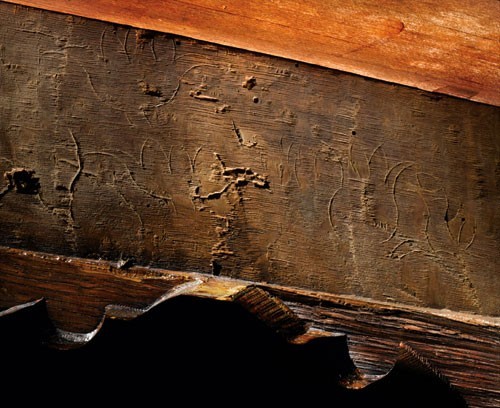
Detail of an end rail of the table illustrated in fig. 41, showing a flower head design laid out with gouge strikes. (Photo, Gavin Ashworth.)
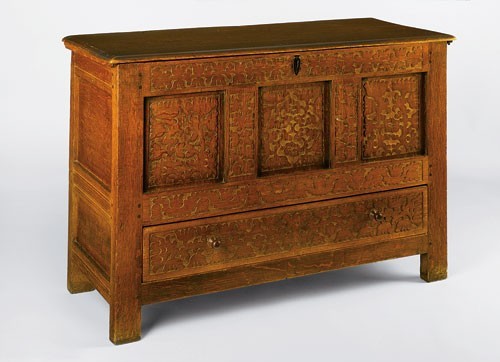
Chest attributed to Nathaniel Gaylord, Windsor, Connecticut, ca. 1680. Oak with yellow pine. H. 30 3/4", W. 46", D. 18 7/8". (Courtesy, Old Sturbridge Village; photo, Gavin Ashworth.)

Detail showing the layout lines and carving on the drawer and façade rails of the chest illustrated in fig. 43. (Photo, Gavin Ashworth.)

Chest, Windsor, Connecticut, ca. 1670. Oak with pine. H. 38 1/2", W. 44 3/4", D. 19 1/2". (Wallace Nutting, Furniture Treasury, 2 vols. [Framingham, Mass.: Old America Co., 1928], 1: fig. 11.)

Box, Windsor, Connecticut, 1670–1710. Oak. H. 8 5/8", W. 30 3/8", D. 15 7/8". (Courtesy, Windsor Historical Society, loan of Grace Episcopal Church.) The lid and bottom board are replacements.

Box, Windsor, Connecticut, 1670–1710. H. 9", W. 28 1/2", D. 15 1/4". Oak with pine. (Courtesy, Farmer’s Museum, Inc.)

Box attributed to Jacob Drake, Windsor, Connecticut, ca. 1680. Oak. H. 9 5/8", W. 24 4/1", D. 20 1/4". (Private collection; photo, Gavin Ashworth.) The hinges are replaced, and the paint may be a modern recreation of the original scheme.
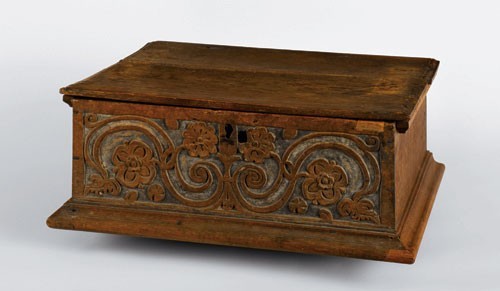
Box, Windsor, Connecticut, ca. 1670. Oak. H. 9 ", W. 241/2", D. 18 7/8". (Courtesy, Antiquarian and Landmarks Society, Inc.; photo, Gavin Ashworth.)

Box, probably Springfield, Massachusetts, ca. 1700. Oak with yellow pine. H. 9 1/4", W. 25 1/4", D. 16 1/4". (Courtesy, Historic Deerfield, Inc.; photo, Gavin Ashworth.)
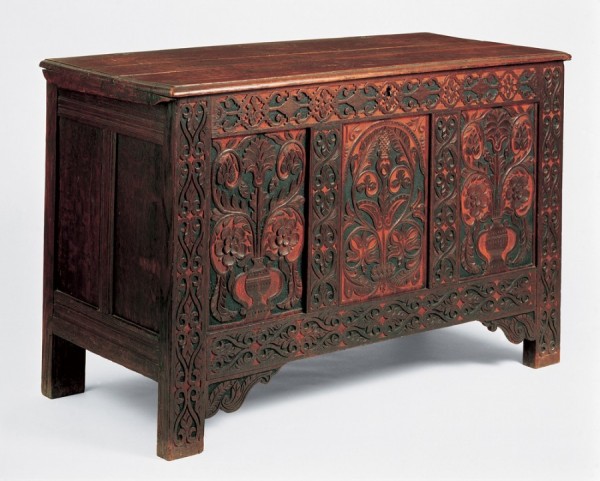
Chest attributed to Thomas Dennis, Ipswich, Massachusetts, 1676. Red and white oak. H. 31 11/16", W. 49 5/8", D. 22 5/8". (Courtesy, Winterthur Museum.)

Chest, probably Suffield, Connecticut, ca. 1730. Woods and dimensions not recorded. (Clair Franklin Luther, The Hadley Chest [Hartford, Conn.: Case, Lockwood & Brainard Co., 1935], p. 103, no. 62.

Chest attributed to Aaron Cook, Windsor, Connecticut, or Northampton, Massachusetts, ca. 1660. Oak with yellow pine. H. 28", W. 56 1/2", D. 20". (Courtesy, Historic Deerfield, Inc.; photo, Gavin Ashworth.) The drawer is missing.
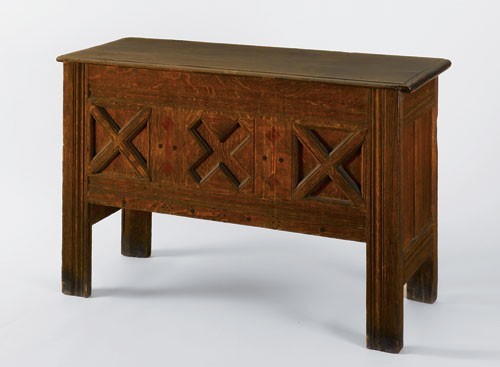
Chest, Windsor, Connecticut, or Hampshire County, Massachusetts, ca. 1680. Oak with yellow pine. H. 30 1/4", W. 47", D. 18". (Courtesy, Pocumtuck Valley Memorial Association, gift of James A. Reed; photo, Gavin Ashworth.) The drawer is missing.

Chest, Windsor, Connecticut, or Hampshire County, Massachusetts, ca. 1680. Oak with yellow pine. H. 30 1/4", W. 47", D. 18". (Courtesy, Historic Deerfield, Inc.; photo, Gavin Ashworth.) The lid and lock are replacements.
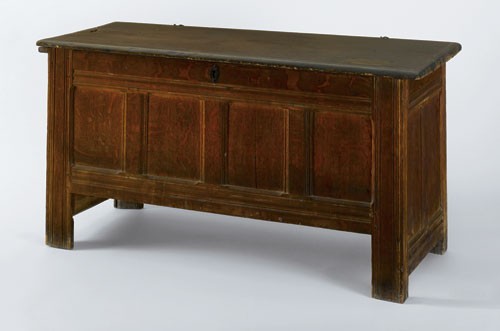
Chest, Windsor, Connecticut, or Hampshire County, Massachusetts, ca. 1680. Oak with yellow pine. H. 26 1/4", W. 51", D. 20 1/2". (Courtesy, Pocumtuck Valley Memorial Association, gift of Mary Wright Davis; photo, Gavin Ashworth.) The drawer is missing.
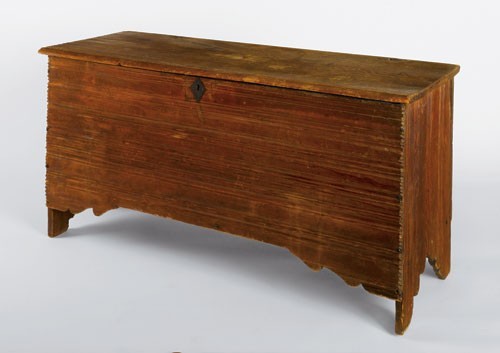
Chest, Windsor, Connecticut, or Northampton, Massachusetts, ca. 1680. Yellow pine. Dimensions not recorded. (Courtesy,
Antiquarian and Landmarks Society, Inc.; photo, Gavin Ashworth.)
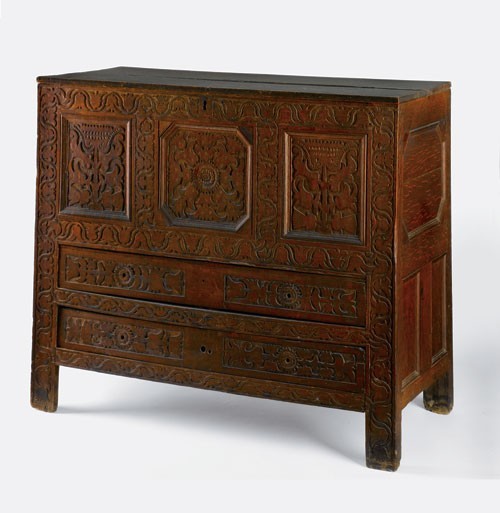
Chest attributed to Thomas Stoughton III or Thomas Stoughton IV, Windsor, Connecticut, ca. 1680. Oak with yellow pine. H. 39 1/2", W. 45 3/4", D. 19 3/4". (Courtesy, Connecticut Historical Society, gift of Thaddeus Mather; photo, Gavin Ashworth.)
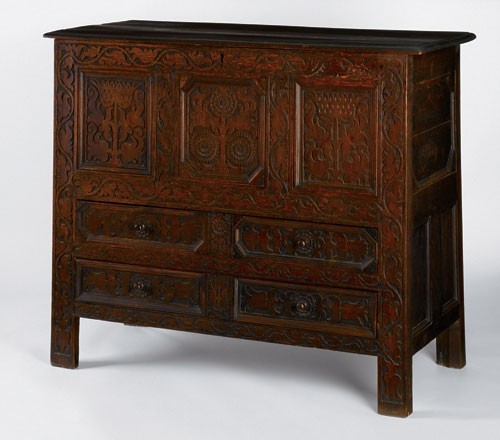
Chest attributed to Thomas Stoughton III or Thomas Stoughton IV, Windsor, Connecticut, ca. 1680. Oak with yellow pine. H. 41", W. 48", D. 20". (Courtesy, Historic Deerfield, Inc.; photo, Gavin Ashworth.) The lid has been altered.

Chest attributed to John Thurston, Dedham or Medfield, Massachusetts, 1660–1685. Oak with pine. H. 31 3/8", W. 47 3/4", D. 21". (Courtesy, Museum of Fine Arts, Boston.)
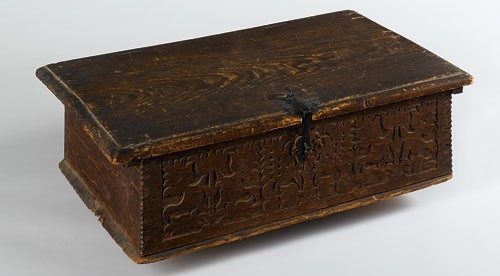
Box attributed to Thomas Stoughton IV, Windsor, Connecticut, ca. 1695. Oak and yellow pine with yellow pine. H. 7 1/2", W. 29", D. 17 1/2". (Private collection; photo, Gavin Ashworth.)

Detail showing the lid, cleats, and till of the box illustrated in fig. 66. (Photo, Gavin Ashworth.)

Detail of the carving on the box illustrated in fig. 66. (Photo, Gavin Ashworth.)
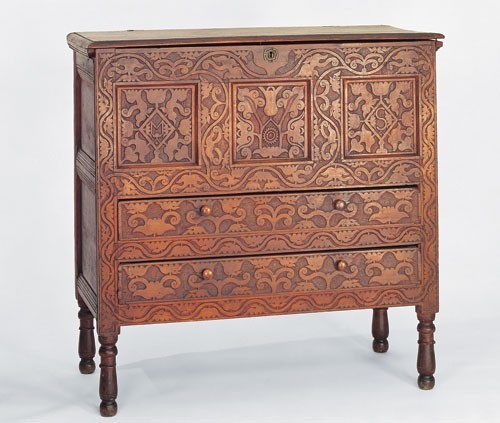
Chest attributed to Daniel White Jr., probably Hatfield, Massachusetts, ca. 1710. Maple with yellow pine. H. 45 1/4", W. 43 1/2", D. 19 3/4". (Courtesy, Wadsworth Atheneum, Wallace Nutting Collection, gift of J. Pierpont Morgan, by exchange and the Evelyn Bonar Storrs Trust Fund.)
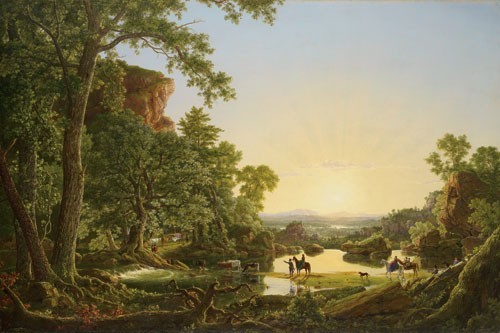
Frederic Edwin Church, Hooker and Company Journeying through the Wilderness, from Plymouth to Hartford, in 1636, 1846. Oil on canvas. 40 1/4" x 60 3/16". (Courtesy, Wadsworth Atheneum, Museum purchase.)
